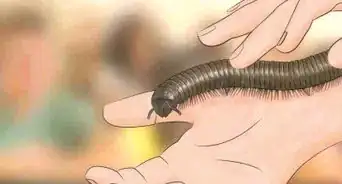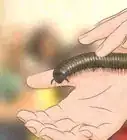This article was co-authored by wikiHow Staff. Our trained team of editors and researchers validate articles for accuracy and comprehensiveness. wikiHow's Content Management Team carefully monitors the work from our editorial staff to ensure that each article is backed by trusted research and meets our high quality standards.
wikiHow marks an article as reader-approved once it receives enough positive feedback. In this case, 84% of readers who voted found the article helpful, earning it our reader-approved status.
This article has been viewed 189,251 times.
Learn more...
Praying mantises are easy-to-keep pets that require minimal care. Although keeping them in an enclosed cage will prevent them from escaping, it is possible to keep them without one. Also, releasing them into your garden or yard is a great way to deal with other insect infestations!
Steps
Keeping a Free-Range Mantis Indoors
-
1Buy a potted plant.[1] Since mantises might cannibalize each other, purchase a plant for each one that you intend to keep. Pick a tall plant so they have plenty of room to climb. Stick to a small pot, however, so they can find their food at the base more easily.
- Choose a plant with plentiful wide leaves so the mantis has adequate shade to escape the sun.
- Since your mantis won’t be enclosed, be sure to select a breed that doesn’t develop wings so it doesn’t fly away and escape![2]
- If the pot is circular, the diameter of the surface area should be at least three times wider than the mantis’s body length. If the pot is box-shaped, it should be twice as wide as the mantis’s body length and three times as long.[3]
-
2Situate your plant. Place it on a windowsill so the plant receives direct sunlight and remains healthy.[4] If your windowsill is too narrow, place your plant where sunlight can reach it. Be sure to keep it out of reach of other pets, since dogs or cats may eat your mantis.Advertisement
-
3Feed your mantis. Collect or purchase other insects with soft bodies to use as pet food. Be sure to use live prey that is only a quarter of the size of the mantis itself.[5] If possible, feed them insects that don’t fly so they don’t escape.
- When using a caged enclosure to house your mantis, it’s recommended to keep a continuous supply of food. But since you’re not using a cage, be vigilant with feeding to make sure the mantis is eating regularly.
- Keep the soil free of fallen leaves or other obstructions where prey can hide.
- Try using tweezers to offer food. This way you can gauge how hungry your mantis is as well as use prey that is able to fly or otherwise escape.
- Fruit flies are a popular food for smaller mantises, and crickets for larger ones.[6]
-
4Maintain the right environment. Keep the room temperature warm. Mist the leaves and soil regularly to maintain proper humidity. Since you’re keeping your mantis in the open instead of an enclosure, keep a sharp eye on the soil to make sure it doesn’t dry out.[7]
- If prolonged sunlight dries your plant quickly on a regular basis, rotate the plant between direct sunlight (for the plant’s health) to other areas in the room where the sun doesn’t reach (to maintain moisture).
- Between regular misting and the moisture received from eating prey, the mantis shouldn’t need another water source. However, for your own peace of mind if this is a concern, go ahead and give it a small water bowl.
Populating Your Whole Garden or Yard
-
1Purchase an egg case. Research which breed of praying mantis you wish to introduce to your garden. Then order one or more egg cases from a garden-supply retailer. Expect each egg case to produce anywhere from 50 to 200 insects. Depending on the size of your yard or garden, buy as many egg cases as needed to populate the area.
- One egg case should produce enough mantises to cover 1666 square feet.[8]
- Plant at least a couple of egg cases in your garden, on the off-chance that one of them is infertile. Once the babies, or “nymphs,” emerge, they will scatter from the case within a couple hours. Since they’re camouflaged (and since the case will appear the same as before), it will be hard to tell when and if this has happened.[9]
-
2Wait for warm weather. Since frost and cold will kill mantises,[10] delay hatching your egg case until the weather turns consistently warm with the approach of summer. Place the egg case in a container that allows air circulation and refrigerate it until spring. Then take it out at least a month or two before you’d like it to hatch.
- While cold weather kills mantises, egg cases are laid in the wild before winter,[11] so refrigerating them is fine.
-
3Plant your egg case. Gently tie the egg case to a loose twig with zip-ties, wire, or twine. Handle the egg case delicately to avoid damaging it. Then find a suitable place in your garden to secure the twig and attached case. Look for an area that’s a couple feet above the ground with enough cover to hide the case from predators.[12] Using the twig as an attachment point, secure the case to low branches or fences.[13]
- Before attaching the egg case to the loose twig, locate the slits from which the babies, or “nymphs,” will emerge. Attach the case to the twig with the slits facing outward.
- Use zip-ties, twine, or wire. Sticky substances like glue or tape may trap the nymphs once they emerge.[14]
-
4Wait for the egg case to hatch. Expect the nymphs to emerge after three to ten weeks of consistent warm weather. Since mantises thrive on humidity, gently water the immediate area in the meantime, especially in dry weather. Lightly mist the ground and leaf-cover on a regular basis.
- As long as other insect-life remains plentiful in your garden, your mantises should have an abundant food source to survive on their own. Each generation has a one-year life cycle and will die off with the approach of cold weather. However, females will lay new egg cases in the fall, so your garden should be repopulated by next spring or summer.[15]
Hatching an Egg Case Indoors
-
1Buy an egg case. Visit a garden-supply retailer or website. Find out which breed of mantis you’d like to keep as an indoor pet and/or introduce to your yard. Expect anywhere from 50 to 200 babies, or “nymphs,” to hatch from a single egg.
-
2Hatch your egg case in warm weather. Since mantises will not survive winter weather,[16] wait for spring or summer to hatch them, once the weather has turned consistently warm. If you buy your egg case early, refrigerate it in a container that allows air to circulate. Then take it out four to eight weeks before you’d like it to hatch.
-
3Place the egg case in a paper bag. Inspect the bag beforehand. Make sure there aren’t any holes or tears. Then place the case inside, fold the bag, and use a paper clip to seal it. Keep it near a window where it will receive direct sunlight.[17]
- Do not use a ziplock bag or any other airtight seal, since the baby nymphs will need air.
-
4Wait for the case to hatch. Expect the nymphs to emerge after three to ten weeks of consistent warm weather. Check inside the bag on a daily basis throughout this time. Once you see tiny nymphs crawling around inside, remove however many you wish to keep as indoor pets and release the rest outside.[18]
- Check the bag regularly, since mantises will likely eat each other if left too long on their own.[19]
- Nymphs are very small and delicate, so be careful how you handle them.[20] Use a plastic spoon to transfer them from the bag to a potted plant. Insert the spoon into the bag and wait for them to climb on, then set the spoon on top of the plant’s soil.
Community Q&A
-
QuestionPraying mantis still eating and drinking, but won't climb, and was lying upside-down this morning. Sitting up now, but won't climb.
 Community AnswerIt is molting, as it will do every couple of weeks. Make sure not to disturb or feed them when they are trying to molt.
Community AnswerIt is molting, as it will do every couple of weeks. Make sure not to disturb or feed them when they are trying to molt. -
QuestionCan I use a fake plant as a substitute for the potted plant?
 Community AnswerYes. Since the plant is just a decoration, you can replace it with a fake plant if you'd prefer.
Community AnswerYes. Since the plant is just a decoration, you can replace it with a fake plant if you'd prefer. -
QuestionCan I keep a mantis in a jar?
 CaeiiaTop AnswererYes, but the jar should have air holes and may be harder to clean because of the small space.
CaeiiaTop AnswererYes, but the jar should have air holes and may be harder to clean because of the small space.
Warnings
- Do not use pesticides where you plan to keep your praying mantis.⧼thumbs_response⧽
- Obviously, if you’re worried about your pet mantis escaping, keeping it in a cage is best. It may wander off, even if you regularly provide it with food.⧼thumbs_response⧽
- If you order an egg case from a retailer outside of your own country, be sure that it’s legal to import the particular breed you’re purchasing.⧼thumbs_response⧽
- Most types of mantises grow wings late in life and may fly away.[21]⧼thumbs_response⧽
References
- ↑ http://mantodea.myspecies.info/rearing-praying-mantids
- ↑ http://www.pestnet.com/praying-mantis/can-praying-mantis-fly/
- ↑ http://www.keepinginsects.com/praying-mantis/care/
- ↑ http://mantodea.myspecies.info/rearing-praying-mantids
- ↑ http://www.keepinginsects.com/praying-mantis/caring-for-mantis-eggs/
- ↑ http://mantodea.myspecies.info/rearing-praying-mantids
- ↑ http://www.keepinginsects.com/praying-mantis/care/
- ↑ http://www.gardeninsects.com/prayingmantis.asp
- ↑ http://www.naturescontrol.com/prayingmantis.html
- ↑ http://www.gardeninsects.com/prayingmantis.asp
- ↑ http://www.gardeninsects.com/prayingmantis.asp
- ↑ http://www.naturescontrol.com/prayingmantis.html
- ↑ http://www.gardeninsects.com/prayingmantis.asp
- ↑ http://www.keepinginsects.com/praying-mantis/caring-for-mantis-eggs/
- ↑ http://www.gardeninsects.com/prayingmantis.asp
- ↑ http://www.gardeninsects.com/prayingmantis.asp
- ↑ http://www.naturescontrol.com/prayingmantis.html
- ↑ http://www.naturescontrol.com/prayingmantis.html
- ↑ http://www.gardeninsects.com/prayingmantis.asp
- ↑ http://www.keepinginsects.com/praying-mantis/caring-for-mantis-eggs/
- ↑ http://www.pestnet.com/praying-mantis/can-praying-mantis-fly/
About This Article
If you want to keep a pet praying mantis but you don’t have a cage, place a tall potted plant in the room where you want to keep your mantis. If the plant is in a circular pot, its diameter should be at least 3 times wider than the length of the mantis. If the pot is rectangular, it should be at least twice as wide as the length of the mantis, and 3 times as long. Mist the plant and soil regularly so they don’t dry out, and make sure your mantis has a continuous supply of live insects like fruit flies or crickets. Keep reading to learn how to populate your garden with praying mantises!












































































